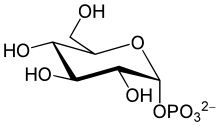Glucose 1-phosphate
 Anionic form of α-D-glucose 1-phosphate | |
 Neutral form of α-D-glucose 1-phosphate | |
| Names | |
|---|---|
| IUPAC name
Glucose 1-phosphate | |
| Other names
Cori ester | |
| Identifiers | |
| 59-56-3 | |
| ChEBI | CHEBI:16077 |
| ChemSpider | 388311 |
| Jmol interactive 3D | Image |
| MeSH | glucose-1-phosphate |
| PubChem | 65533 |
| |
| |
| Properties | |
| C6H13O9P | |
| Molar mass | 260.13 g·mol−1 |
| Except where otherwise noted, data are given for materials in their standard state (at 25 °C [77 °F], 100 kPa). | |
| | |
| Infobox references | |
Glucose 1-phosphate (also called cori ester) is a glucose molecule with a phosphate group on the 1'-carbon. It can exist in either the α- or β-anomeric form.
Reactions of α-glucose 1-phosphate
Catabolic
In glycogenolysis, it is the direct product of the reaction in which glycogen phosphorylase cleaves off a molecule of glucose from a greater glycogen structure.
To be utilized in cellular catabolism it must first be converted to glucose 6-phosphate by the enzyme phosphoglucomutase. One reason that cells form glucose 1-phosphate instead of glucose during glycogen breakdown is that the very polar phosphorylated glucose cannot leave the cell membrane and so is marked for intracellular catabolism.
Anabolic
In glycogenesis, free glucose 1-phosphate can also react with UTP to form UDP-glucose, by using the enzyme UDP-glucose pyrophosphorylase. It can then return to the greater glycogen structure via glycogen synthase.
β-Glucose 1-phosphate
β-Glucose 1-phosphate is found in some microbes. It is produced by inverting α-glucan phosphorylases including maltose phosphorylase, kojibiose phosphorylase and trehalose phosphorylase and is then converted into glucose 6-phosphate by β-phosphoglucomutase.
See also
| ||||||||||||||
| ||||||||||||||||||||||||